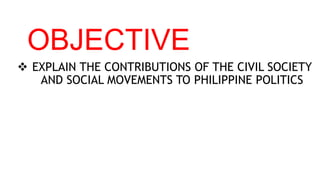
social movement in ph.ppt
- 1. OBJECTIVE EXPLAIN THE CONTRIBUTIONS OF THE CIVIL SOCIETY AND SOCIAL MOVEMENTS TO PHILIPPINE POLITICS
- 2. IDENTITY GAME (Choices: Advocacy group, social movement or third setor) •Gabriela •Philippine Red Cross •FB page of a popular love team •Kilusang Mayo Uno
- 3. ACTIVITY •In groups, let the students establish an advocacy group, social movement or a third sector group to address a prevailing issue/concern on the locality (San Lorenzo, REV-SLNHS or Guimaras)
- 4. ANALYSIS •What are the issues that you were trying to address? •How will you address the issue/s? •With whom will you connect to address the issue/s?
- 5. Social movement - a collective, organized, sustained and non-institutional challenge to authorities, powerholders, or cultural beliefs and practices.
- 6. Civil Society • a community of individuals who share common interests usually in terms of government policies
- 7. “Social Capital” “the features of social organization, such as networks, norms, and trusts, that facilitate coordination and cooperation for mutual benefit.” when people are active in social networks they develop relationships of trust and reciprocity that sustain a healthy social and political community.
- 8. “Contentious Politics” “Contentious politics occurs when ordinary people…join forces in confrontations with elites, authorities, and opponents” “Collective action becomes contentious when it is used by people who lack regular access to institutions, who act in the name of new or unaccepted claims, and who behave in ways that fundamentally challenge others or authorities”
- 9. “Contentious Politics” “Particular groups have a particular history – and memory – of contentious forms. Workers know how to strike because generations of workers struck before them In Ph setting, countless strikes and protest rallies were staged to show political contentions of the various groups; commonly staged during Labour Day and EDSA Anniversary
- 10. Advocacy Group Tactics Range of tactics and activities from formal to informal, or traditional to nontraditional Formal end of the spectrum includes various forms of lobbying and consultations with government. Informal end of the spectrum includes rallies and protests, holding sit-ins or engaging in civil disobedience. Ultimately, some groups may engage in violence against private or public property or against people.
- 11. Tactical Innovations in the Ph Civil Rights Movement Transport strikes Street protests Freedom Run/Walk Community-Wide Protest Campaigns Riots
- 12. Theorizing Collective Action Pluralism Marxist theory Rational choice theory Resource mobilization theory New social movement theory Political process model
- 13. Pluralism The classic post-war view of the role of interest groups. Assumes that political power is dispersed among various interest groups. People have various identities and interests and society is comprised of various cross-cutting cleavages, such that no one is consistently a winner or loser in the political arena and stability is assured. The state is viewed as a neutral arena in which groups freely compete for resources
- 14. Marxist/Socialist Theory Views society as comprised of socio-economic classes, based on peoples relation to ownership and control of means of production. The primary cleavage in capitalist society is the class cleavage between workers and owners. The state is viewed as aligned with the capitalist class and dedicated towards maintaining the conditions for capital accumulation (including, if necessary, through coercion).
- 15. Rational Choice Theory the individual seeks to maximize personal utility; Rational choice theorists try to figure out how collective action is even possible among individuals guided by narrow self-interest. Basically, they assume that collective action is generally unlikely to happen. Individuals are not naturally inclined to sociability or group politics (unlike pluralist view), collective action must be explained rather than assumed; contrasts public goods that everyone benefits from and private goods that are restricted only to some;
- 16. Social Movement Theories Resource Mobilization Theory New Social Movement Theory Political Process Model
- 17. Resource Mobilization Theory Emphasizes the importance of internal group resources focus on questions of resources such as organization, money, leadership, allies, expertise social movement activities are not spontaneous and disorganized and social movement participants are not irrational
- 18. New Social Movement Theory Focuses on identity and culture in movement formation and activism collective identity formation and cultural struggle; redefining and challenging ideas, identity and culture identities are constructed, they are a process, they are fluid. All collective action needs to be understood at least in part in terms of identity formation. The practices of collective action shape identities and the formation of identities shapes practices of collective action.
- 19. Political Process Model includes analysis of external environment. combines elements of both theories RMT and NSMT along with a focus on the broader political environment that facilitates (or not) the development and success of movements, or the “political opportunity structure” Political Opportunity Structure: “consistent – but not necessarily formal, permanent or national – dimensions of the political struggle that encourage people to engage in contentious politics”
- 20. Political Process Model Five key dynamic components: 1. the relative openness or closure of the institutionalized political system; 2. the stability or instability of that broad set of elite alignments that typically undergird a polity; 3. divided elites; 4. the presence or absence of elite allies; 5. and the state’s capacity and propensity for repression.
- 21. Political Process Model Political opportunity structures can constrain or expand the field of collective action in four ways: 1. they expand the group’s own opportunities; 2. they expand opportunities for others; 3. create opportunities for opponents 4. and create opportunities for elites
- 22. Interest Groups and Democracy Interest groups pursue their collective objectives mainly through institutionalized means whereas social movements pursue their ends mainly via the use of noninstitutional means (conducting marches, boycotts, sit-ins).